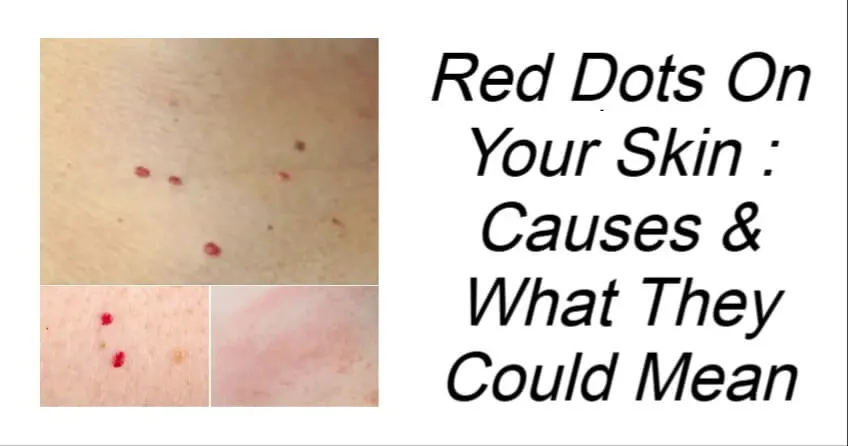Common Causes of Red Dots on Skin: What You Need to Know
Red dots on the skin can appear for various reasons, some of which may resolve on their own, while others may require medical attention. If you’ve noticed red spots on your skin, it could be due to a wide range of factors, including allergies, infections, and vascular issues. Understanding the underlying cause of these red spots is crucial for determining the appropriate treatment or intervention. Here are some of the most common reasons for red dots on the skin:
1. Allergic Reactions
Allergic reactions are one of the most common causes of red spots on the skin. Whether you’re allergic to food, medications, insect stings, or other environmental factors, an allergic response can cause red, itchy bumps or hives. These spots may vary in size and shape, depending on the severity of the allergic reaction.
2. Acne Scars
Acne scars can sometimes appear as red or purple spots on the skin, particularly after an acne breakout. These spots are usually temporary and may fade with time as the skin heals. However, in some cases, they may require treatment to reduce their appearance.
3. Vascular Birthmarks (Hemangiomas)
Vascular birthmarks, such as hemangiomas, are often present at birth and appear as red or purple spots on the skin. These birthmarks occur when blood vessels grow abnormally. While most hemangiomas are harmless and fade as the child grows, some may require medical attention if they interfere with vision or other functions.
4. Angiomas
Angiomas, including cherry angiomas, are small, raised red bumps caused by the growth of extra blood vessels. These benign growths are common, especially as people age, and are typically harmless. However, if they become painful or bleed, it’s a good idea to consult with a doctor.
5. Petechiae (Purple Dots)
Petechiae are tiny, purple, or red dots that occur when capillaries under the skin burst, leading to small areas of bleeding. These dots can be triggered by various factors, such as extreme stress, heavy coughing, or certain medications. While petechiae are often harmless, they can sometimes indicate underlying issues with blood clotting or platelet function, and medical attention may be necessary.
6. Heat Rash (Prickly Heat)
Heat rash, also known as prickly heat, occurs when sweat gets trapped in sweat ducts, causing itchy red spots on the skin. This is most common in hot, humid weather or after strenuous physical activity. The rash usually resolves on its own once the skin cools and sweat is able to evaporate.
7. Bug Bites and Stings
Insect bites, including those from mosquitoes, fleas, or bedbugs, can cause red, itchy bumps. These spots may be accompanied by swelling and irritation. In most cases, the spots will go away on their own, but if they become infected or persist, you may need treatment.
8. Folliculitis (Itchy Scabies)
Folliculitis is an infection of the hair follicles caused by bacteria or fungi, leading to red bumps filled with pus. These bumps may be painful, itchy, and inflamed. In some cases, folliculitis can lead to scarring if not treated promptly.
9. Vasculitis
Vasculitis is a condition that involves inflammation of the blood vessels, which can result in red or purple spots on the skin. This condition is often linked to autoimmune disorders or infections. Vasculitis can be serious and may require medical intervention to address the underlying cause.
10. Leaky Capillaries and Blood Vessel Issues
Capillary leakage can cause blood to escape into the skin, leading to the appearance of red or purple dots. This may happen due to certain medical conditions or injuries that affect the integrity of the blood vessels. In severe cases, this can indicate a more serious underlying issue.
11. Hemangiomas (Vascular Tumors)
Hemangiomas are clusters of abnormal blood vessels that can form raised, red spots on the skin. These benign growths are generally harmless, but in some cases, they may require medical intervention, especially if they cause pain, bleeding, or other complications.
When to Seek Medical Help
While many causes of red dots on the skin are benign and resolve on their own, it’s important to be aware of certain warning signs that require medical attention. If you notice any of the following, consult a healthcare professional:
- Red spots that don’t fade or change with time
- Increased size or pain around the red spots
- Signs of infection, such as pus or warmth
- Sudden or unexplained appearance of petechiae
- Red dots accompanied by other symptoms like fever, fatigue, or joint pain
Conclusion
Red spots on the skin can result from a variety of factors, ranging from harmless conditions like acne scars and heat rash to more serious issues like vasculitis or allergic reactions. By understanding the possible causes, you can better identify whether the red dots on your skin are something to worry about or if they will resolve naturally. Always consult with a healthcare professional if you’re unsure or if the spots persist or worsen.



